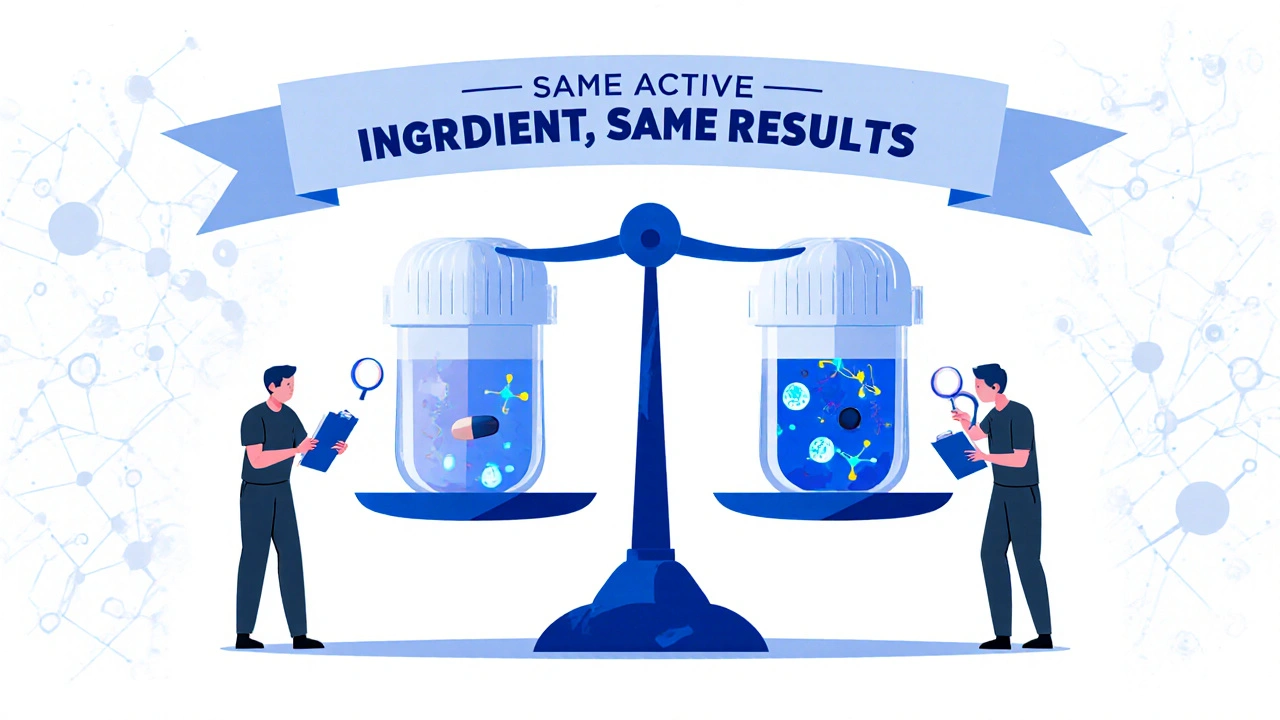
When you pick up a prescription, you might see a generic version on the shelf instead of the brand name you recognize. It’s cheaper, sure-but is it just as safe? The answer isn’t guesswork. The U.S. Food and Drug Administration (FDA) has a strict, science-backed system to make sure generic drugs are just as safe and effective as their brand-name counterparts. This isn’t about cutting corners. It’s about following the same rules, with the same level of scrutiny.
Same Active Ingredient, Same Results
Every generic drug must contain the exact same active ingredient as the brand-name drug. That means if your brand-name pill has 10 mg of lisinopril, the generic has 10 mg of lisinopril-no more, no less. The FDA requires this in writing under 21 CFR 314.94(a). It’s not a suggestion. It’s a legal requirement.
But it’s not just about what’s in the pill. The dosage form matters too. If the brand is a tablet you swallow, the generic must be a tablet you swallow. Same strength. Same route-oral, injectable, topical. No swapping capsules for patches unless the FDA specifically allows it. This ensures the drug enters your body the same way, every time.
Bioequivalence: The Real Test
Here’s where most people get confused. You might think, “If the ingredient is the same, why do I need more testing?” The answer is absorption. Two pills with the same active ingredient can behave differently in your body if they dissolve at different rates or are absorbed unevenly.
To solve this, the FDA requires bioequivalence studies. These are clinical trials with healthy volunteers-usually 24 to 36 people-who take both the generic and the brand-name drug under controlled conditions. Researchers measure two key things: Cmax (the highest concentration in the blood) and AUC (how much of the drug gets absorbed over time).
The FDA’s rule? The generic’s results must fall within 80% to 125% of the brand’s. That’s not a wide margin-it’s a tight one. For drugs with a narrow therapeutic index-like warfarin, levothyroxine, or phenytoin-the standard is even stricter: 90% to 111%. These are drugs where even a small difference can cause harm. The FDA treats them with extra caution.
These studies aren’t done once and forgotten. The FDA reviews every single one. In 2023 alone, they evaluated over 1,000 applications for generic drugs. And if a study doesn’t meet the standard? It gets rejected. No exceptions.
Manufacturing Under the Same Rules
Just because a drug works the same doesn’t mean it’s made the same way. The FDA requires all manufacturers-whether they make brand-name or generic drugs-to follow Current Good Manufacturing Practices (cGMP). This means:
- Every step of production is documented and audited
- Equipment is cleaned, calibrated, and maintained with records
- Facilities are inspected regularly-both in the U.S. and overseas
Over 50% of generic drug manufacturing happens outside the U.S., mostly in India and China. The FDA doesn’t trust paperwork alone. They send inspectors to those facilities. Since 2020, their Risk-Based Facility Assessment program has increased overseas inspections by 22%. That’s not luck. It’s policy.
Impurities? Also tightly controlled. The FDA follows international guidelines (ICH Q3B and ICH M7) to set limits on harmful substances. For example, any potential carcinogen must be below 1.5 micrograms per day-a level so low it’s nearly undetectable. If a batch exceeds that, it’s destroyed.
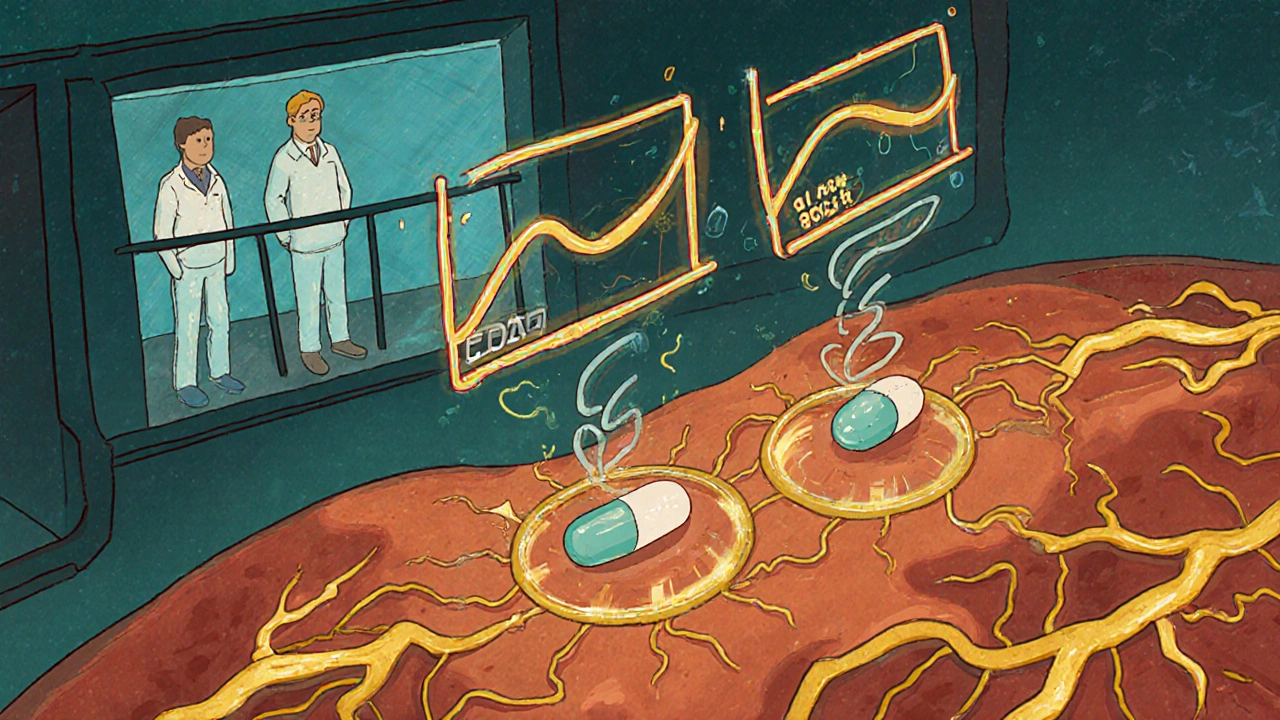
Labeling: Identical, Except for the Fine Print
The warning labels, dosage instructions, and side effect lists on generic drugs must match the brand-name version exactly. The FDA calls this “the same as.” You won’t find a generic drug with weaker warnings or missing safety information.
What can be different? The color, shape, size, flavor, or inactive ingredients-like fillers, dyes, or preservatives. These don’t affect how the drug works. But they can affect people with allergies. That’s why the FDA requires manufacturers to list all inactive ingredients clearly. If you’re allergic to lactose or a certain dye, you can check the label and choose accordingly.
Complex Drugs: Where Things Get Harder
Not all drugs are created equal. Simple pills? Easy to copy. But inhalers, eye drops, topical creams, and injectables? These are complex. Their effectiveness depends on how the drug is delivered-not just what’s inside.
For example, an asthma inhaler must deliver the same particle size, spray pattern, and dose consistency as the brand. The FDA found in 2022 that 25% more ANDAs (Abbreviated New Drug Applications) for complex generics get rejected compared to simple tablets. Why? Because measuring equivalence is harder. Sometimes, manufacturers have to prove it through clinical endpoint studies or advanced lab tests-not just blood levels.
Even then, challenges remain. In 2013, Teva petitioned the FDA to require immunogenicity testing for generic versions of Copaxone (a multiple sclerosis drug). The FDA agreed-this wasn’t just chemistry. It was biology. And that’s now part of the standard for certain biologics.
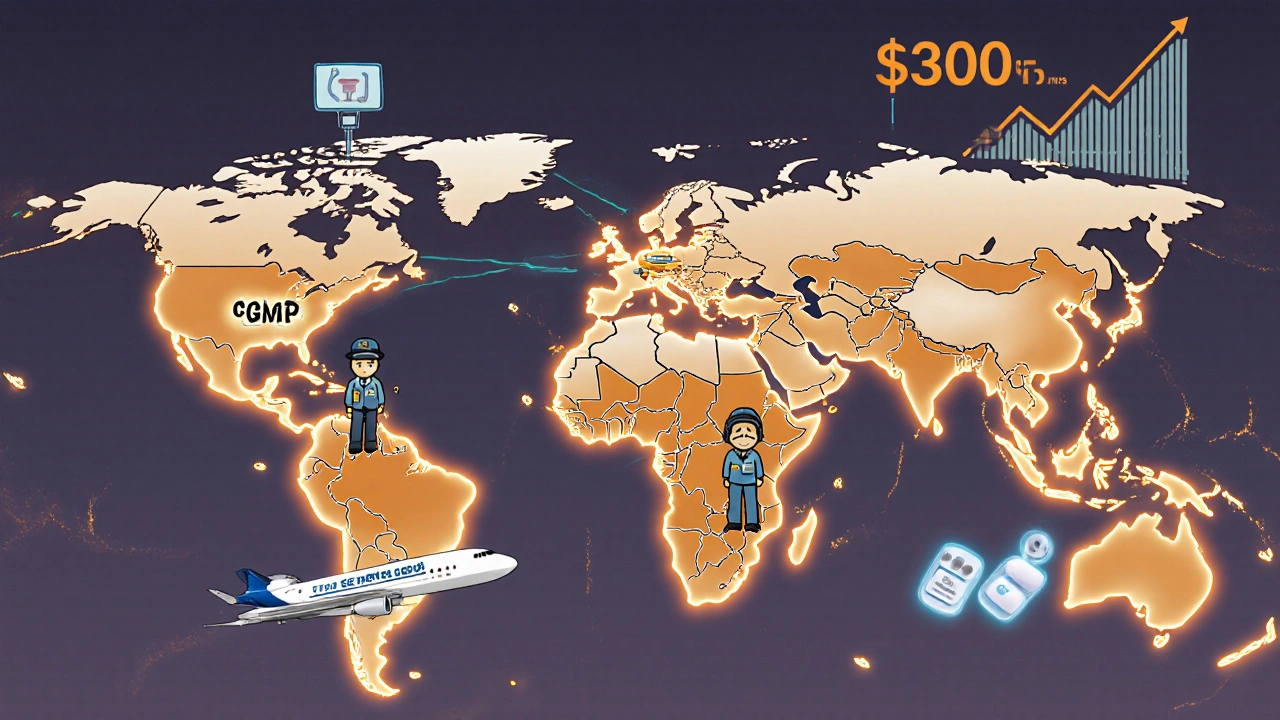
What Do Real Patients and Doctors Say?
Most people don’t notice a difference. A 2022 study in JAMA Internal Medicine looked at 38,000 Medicare patients taking statins. No difference in heart attacks, strokes, or hospitalizations between brand and generic. A review of 12,500 patient reviews on Drugs.com showed 87% reported identical effectiveness for cardiovascular generics.
But some exceptions exist. On Reddit’s r/pharmacy community, a January 2023 thread with over 1,200 comments revealed that 32% of users reported changes in symptoms when switching generic levothyroxine brands. The FDA’s bioequivalence range for this drug is 90-111%, which should be tight enough. But thyroid hormones are sensitive. Even tiny shifts can cause fatigue, weight gain, or anxiety. That’s why some doctors prefer to keep patients on the same generic brand.
Neurologists are split. A 2021 survey found 68% trusted generic antiseizure drugs. But only 42% felt the same about complex MS treatments. That’s not distrust in generics-it’s caution with complexity.
Why Generics Are So Much Cheaper
Generics cost less because they don’t repeat expensive clinical trials. Brand-name companies spend billions on research, animal testing, and Phase I-III trials. Generics skip all that. They use the FDA’s approved data from the original drug.
Instead, they focus on proving bioequivalence and manufacturing quality. That cuts development time from 10-15 years to 3-5. The average cost to develop a generic? $1-2 million per bioequivalence study. Compare that to $2.6 billion for a new brand-name drug.
The result? Generics make up 90% of prescriptions filled in the U.S. But they account for only 23% of total drug spending. In 2022, Americans saved over $300 billion by choosing generics.
What’s Changing Now?
The FDA isn’t standing still. In 2022, they proposed a rule allowing generic manufacturers to update safety labels faster-without waiting for the brand-name company to act. That’s a big shift. Before, only the original maker could add new warnings. Now, if a generic discovers a new risk, they can alert the public sooner.
The FDA is also investing in AI. A pilot program with MIT is testing machine learning tools to predict dangerous impurities before they appear in batches. That could catch problems before a drug even hits shelves.
And funding? The Generic Drug User Fee Amendments (GDUFA) program, which started in 2012, has cut approval times by 35%. But the Congressional Budget Office warns that by 2027, the FDA will need a 15% funding increase to keep up with complex generics. Without it, review delays could slow access to affordable drugs.
Bottom line: Generic drugs aren’t second-rate. They’re rigorously tested, closely monitored, and legally required to perform the same as brand-name drugs. For most people, they’re the smart, safe choice. For complex conditions, doctors may recommend sticking with one brand-but that’s not because generics are unsafe. It’s because every body responds differently, and consistency matters.
Are generic drugs as safe as brand-name drugs?
Yes. The FDA requires generic drugs to meet the same safety and efficacy standards as brand-name drugs. They must contain the same active ingredient, strength, dosage form, and route of administration. They must also prove bioequivalence through clinical testing and follow the same manufacturing rules (cGMP). The FDA inspects manufacturing sites worldwide and monitors adverse events just like they do for brand-name drugs.
Why do generic drugs look different from brand-name drugs?
By law, generic drugs can’t look identical to brand-name drugs-that would violate trademark rules. So they may differ in color, shape, size, or flavor. These differences are only in inactive ingredients like dyes or fillers, which don’t affect how the drug works. But if you have allergies (like to lactose or certain dyes), you should always check the label.
Can I switch between different generic brands?
For most drugs, yes. All FDA-approved generics must meet the same bioequivalence standards. But for drugs with a narrow therapeutic index-like levothyroxine, warfarin, or seizure medications-some doctors recommend sticking with the same generic brand. Even small differences in absorption can affect how you feel. If you notice changes after switching, talk to your pharmacist or doctor.
Are generic drugs made in the same factories as brand-name drugs?
Sometimes. Many brand-name companies also make generic versions of their own drugs. Other times, generics are made by independent manufacturers, often overseas. The FDA inspects all of them using the same standards. In 2022, nearly half of all generic drug facilities were located outside the U.S., and the FDA increased overseas inspections by 22% since 2020 to ensure quality.
What if I think my generic drug isn’t working?
Don’t assume it’s the generic. Many factors can affect how a drug works-diet, other medications, stress, or even changes in your health. But if you notice new side effects or reduced effectiveness after switching to a generic, report it to your doctor. You can also ask your pharmacist to check if you switched between different generic manufacturers. In rare cases, switching back to the original brand or staying on one generic brand may help.

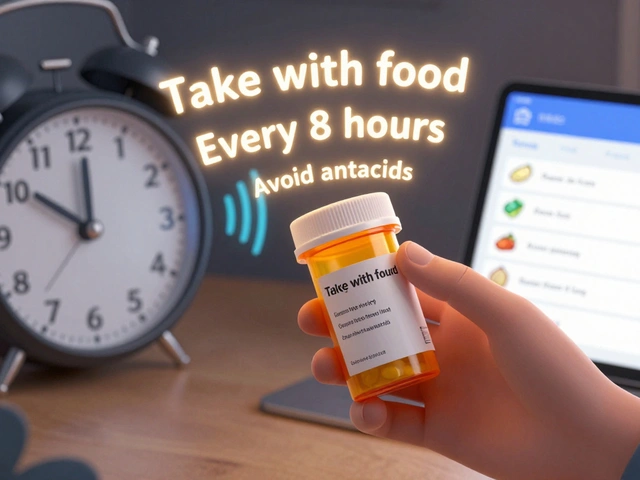
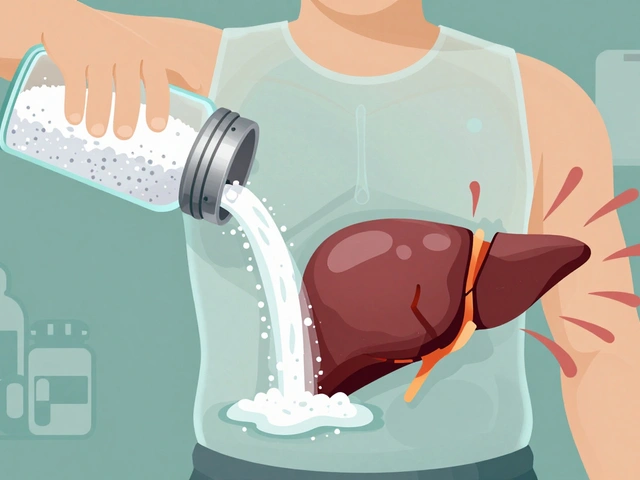

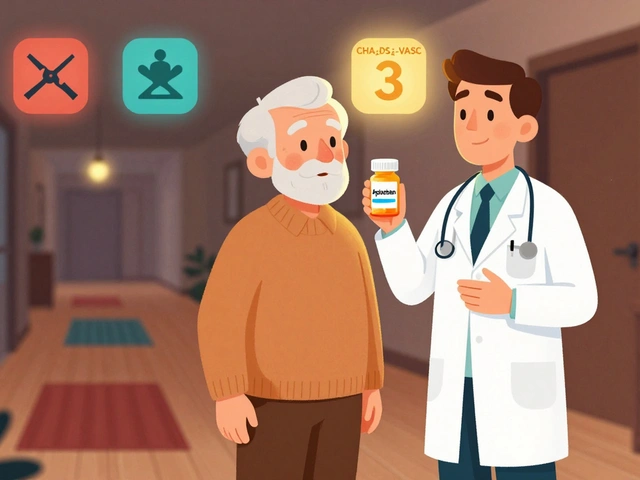
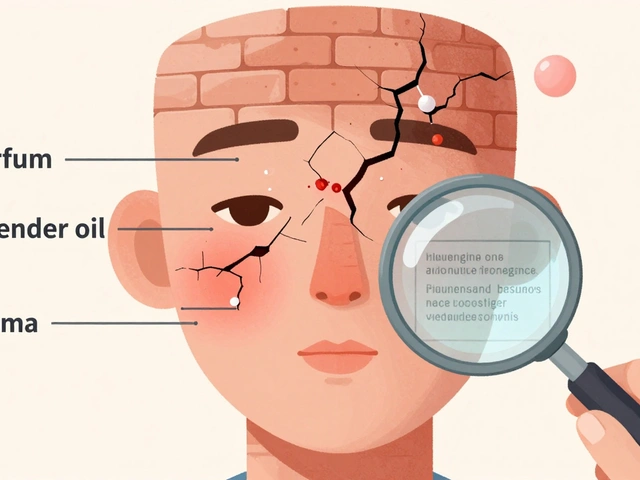
12 Comments
generic drugs are fine unless you get the one from india that makes you feel like your brain is melting
i work in a pharmacy in delhi and we ship to the us all the time. the quality is actually really good if you pick the right manufacturer. not all generics are made equal but the fda checks them. no drama.
the fda is just a front for big pharma. they let the same companies make brand and generic so they can keep profits rolling. you think they inspect factories? nah they just look at pdfs sent by chinese bureaucrats with a smiley face emoji 😅
bro the science is wild. same active ingredient but the fillers? totally different. i had a buddy switch from one generic levothyroxine to another and he started feeling like a zombie. turned out the new one had lactose and he was borderline allergic. tiny change big impact. fda knows this which is why they keep the 90-111% range tight for thyroid meds. real talk: consistency > savings when your hormones are involved
bioequivalence studies are the unsung heroes here. 24-36 healthy volunteers, fasting, controlled conditions, blood draws every 30 minutes for 72 hours. cmax and auc aren’t just jargon - they’re the gatekeepers of your safety. and for complex drugs like inhalers? they use laser diffraction and computational fluid dynamics to match particle size. this isn’t guesswork. it’s precision engineering with a human face.
you ever think about how much trust we put into a little pill? we swallow it without knowing who made it, where it came from, what’s in the filler. and yet we expect it to work the same every time. it’s beautiful really. the system isn’t perfect but it’s built on layers of science, regulation, and accountability. not just profit. not just convenience. real accountability. and that’s rare in modern medicine.
as someone who’s been on generic antidepressants for 8 years and switched brands three times, i’ve seen the subtle shifts. one made me feel emotionally numb, another gave me headaches, the third? perfect. it’s not that generics are bad - it’s that our bodies are finicky little machines. i always tell my clients: if you feel different after a switch, don’t ignore it. talk to your pharmacist. they’ve seen this a thousand times. and yes, the fda’s standards are solid - but they don’t account for individual biochemistry. that’s on us to notice and speak up.
also, i love that the fda now lets generics update safety labels independently. that’s huge. it means the system is learning, not just checking boxes. thank you, science.
so the fda says generics are equal but we all know the brand name one tastes better. also why do they make generic adderall look like a neon green pebble? is this a joke? 😏
the regulatory framework governing bioequivalence, cGMP compliance, and impurity thresholds is grounded in internationally harmonized standards, namely those promulgated by the International Council for Harmonisation. the adherence to these protocols ensures pharmacokinetic parity, thereby minimizing interpatient variability in therapeutic outcomes. furthermore, the risk-based inspection paradigm deployed by the fda constitutes a robust mechanism for supply chain integrity.
generic drugs are fine until you get the one that makes you feel like your soul left your body for 3 days. i switched from brand to generic and started having panic attacks. turned out the filler was corn starch and i had a hidden allergy. fda says its fine but i still dont trust it. also the pill looks like it was made by a 12 year old with a printer
how can you possibly trust a drug made in a factory where the workers don’t even speak english? the fda is asleep at the wheel. this is why people are getting sick. this is why the opioid crisis happened. they prioritize cost over safety and now we’re paying with our lives.
lol jennie zhu just quoted the fda manual like it’s the bible. i love it. but honestly? she’s right. the system works. the problem isn’t the generics - it’s the people who think ‘cheaper’ means ‘worse’. the real villain? misinformation. and maybe that neon green adderall pill.